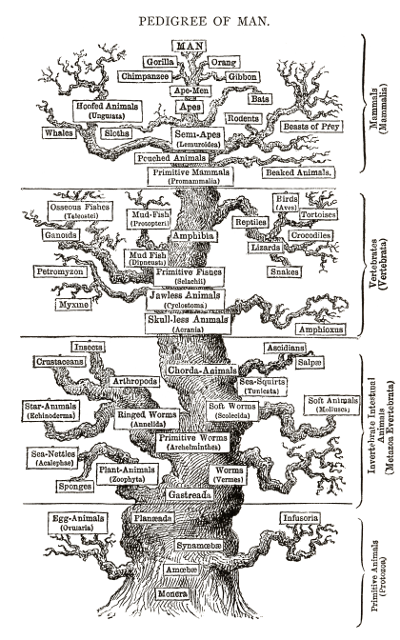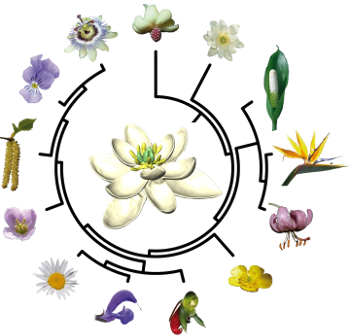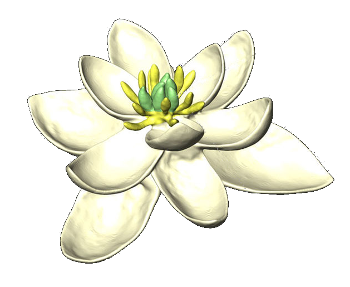The First Angiosperm
September 18, 2017
Humans have a fascination with
firsts; and, rightly so, since they often mark significant accomplishments for
mankind. Notable firsts include the first man to run a
four-minute-mile (
Roger Bannister in 1954), the first ascent of
Mount Everest by
Edmund Hillary and
Tenzing Norgay in 1953, the first man in
space (
Yuri Gagarin in 1961), and the
first man to walk on the
Moon (
Neil Armstrong in 1969).

Soviet cosmonaut, Yuri Gagarin, the the first man in space, in a 1963 photo.
Gagarin died in 1968 in the crash of a MiG-15 training jet he was piloting.
It's suspected that the root cause of the crash was faulty weather information provided by an air traffic controller.
RIA Novosti photo via Wikimedia Commons.
Scientists are often motivated to be the first to make a discovery, and they enjoy establishing
priority in the
publication of scientific results. That's why
scientific journals print the submission date for
manuscripts along with the publication date. This
competition for priority is mostly friendly, since science involves sharing, rather than hoarding,
data, so competing
research teams will often arrange to publish their results in separate articles, but in the same journal on the same date. One example of this is the discovery of the
J/psi meson, discovered independently by the
Stanford Linear Accelerator Center and
Brookhaven National Laboratory, and jointly announced in 1974.
There's a saying in the
Bible (Matthew 20:16) about the last being the first, and this is true for
organisms known as the
last common ancestor. The
last common ancestor is actually the
first individual from which all organisms in a particular group are directly
descended. The ultimate
first in this case is the
last universal common ancestor, the last common ancestor of all life now on the
Earth. This
progenitor of all life we now see could have existed as early as 3.8 billion years ago.

Darwin speculated about our last universal common ancestor having originated in a "warm little pond."[1]
Ernst Haeckel (1834–1919) depicted a tree of life ascending to man, the pinnacle of evolution, at least by anthropocentric standards.
On the left, Haeckel's 1879 Tree of Life, via Wikimedia Commons.
(Click for larger image.)
One interesting species adaptation is the emergence of the
flowering plants, the
angiosperms. Flowers have a multiple purpose. They contain the
reproductive parts of the plants, and the flowers are designed to attract
pollinators, such as
birds and
insects. Once
fertilization occurs, the flower is host to
seed-bearing fruit. The flowers are designed to prevent
cross-breeding that could cause
crossing back with related
species and a lessened
diversity. As a consequence, angiosperms evolved to fill a wide range of
ecological niches, so there are nearly 300,000 known angiosperm species in about 13,000
genera and 416
families. Charles Darwin himself was amazed at the rapid rate at which flowering plants diversified.
A huge international research team,[2] calling itself the eFLOWER project,
data mined scientific papers and created a huge
database of modern flower structures, including their
sexual organs and the layout of their
petals.[3-8] Through an
analysis of their more than 13,000 database entries that went back as far as a 1783 description by
Jean-Baptiste Lamarck, combined with
DNA and
fossil information, the research team was able to deduce the most likely structure and shape for the earliest flowers.[4]
The angiosperms (flowering plants) comprise about 90% of all plants on Earth, and it's believed that they evolved about 140 million years ago from seed plants that existed 310–350 million years ago.[3] The fossil record for angiosperms goes back just 130 million years, so the first 10 million years of angiosperm evolution is unknown.[3-4,6-7] Modern analytical methods allow the inference of such evolution without a fossil record via the distribution of floral traits among extant angiosperms combined with models of
morphological evolution.[3]
To that end the research team assembled their database of 13,444 referenced data points that sampled 792 species from 63
orders (98%) and 372 families (86%) of angiosperms.[3,6] The team inferred twenty-seven floral traits through
computer-assisted
maximum parsimony,
maximum likelihood estimation, and a reversible-jump
Markov Chain Monte Carlo Bayesian analysis.[3] The multiple
models of morphological evolution derived from such an analysis were
calibratedd with 136 fossil constraints.[3,6] The result was the first model-based reconstruction of ancestral flowers at the earliest stage of angiosperm evolution.[3

Angiosperm evolutionary tree, radiating from the last common ancestor.
University of Vienna image copyright Hervé Sauquet/Jürg Schönenberger.
Essentially, the research team looked at the structural transitions at each branching point on the angiosperm evolutionary tree and dug down to what the flower of the last common ancestor might have looked like.[6] What they found was that the last common ancestor was
bisexual and
radially symmetric with
whorls of three petals each.[3,6] This discovery overturns the previous idea that early flowers had a
spiral arrangement that later evolved to the whorled configuration that's prevalent today.[5-6] This ancestral flower has no match among today's flowers.[4,8]
The appearance of the angiosperm last common ancestor suggests that plants evolved by natural selection to a less complicated floral plan.[7] It must be remarked that the structure of this earliest angiosperm is still just
speculative, but the method by which it was obtained makes it a very good
guess.[6] A more complete fossil record would dispel any doubts.[5]

The purported last common ancestor of the angiosperms.
Fig. 1 (simplified) of Ref. 3, licensed under a Creative Commons Attribution 4.0 International License[3]
![]()
References:
- Letter of Charles Darwin to J. D. Hooker, February 1, 1871.
- The host institutions are the Université Paris-Sud (Orsay, France), the University of Vienna (Vienna, Austria), Ciudad Universitaria (México City, México), the University of California (Davis, California), the University of Zurich (Zurich, Switzerland), the University of London (Surrey, UK), the Pontificia Universidad Católica de Chile (Santiago, Chile), the University of Munich (Munich, Germany), the Muséum National d'Histoire Naturelle (Paris, France), the Universidade de São Paulo (São Paulo, Brazil), the University of Sydney (Sydney, Australia), the Royal Botanic Garden Edinburgh (Edinburgh, UK), ETH Zurich (Zurich, Switzerland), the Universidade de Lisboa (Lisboa, Portugal), Harvard University (Cambridge, Massachusetts), the University of Gothenburg (Göteborg, Sweden), and The University of Hong Kong (Hong Kong, China).
- H. Sauquet, M. von Balthazar, S. Magallón, J.A. Doyle, P.K. Endress, E.J. Bailes, E. Barroso de Morais, K. Bull-Hereñu, L. Carrive, M. Chartier, G. Chomicki, M. Coiro, R. Cornette, J.H.L. El Ottra, C. Epicoco, C.S.P. Foster, A. Haevermans, T. Haevermans, R. Hernández, F. Jabbour, S.A. Little, S. Löfstrand, J.A. Luna, J. Massoni, S. Nadot, S. Pamperl, C. Prieu, E. Reyes, P. dos Santos, K.M. Schoonderwoerd, S. Sontag, A. Soulebeau, Y. Städler, G.F. Tschan, A. Wing-Sze Leung, J. Schönenberger, "The ancestral flower of angiosperms and its early diversification," Nature Communications, Article no. 16047 (In press, August 1, 2017), doi:10.1038/ncomms16047. This is an open access article with a PDF file here.
- Patrick Monahan, "The world's first flower may have looked like this," Science, August 1, 2017, DOI: 10.1126/science.aan7188.
- What flowers looked like 100 million years ago, University of Vienna Press Release, August 1, 2017.
- Nicola Davis, "Mother of all blooms: is this what the last common ancestor of flowers looked like?" The Guardian (UK), August 1, 2017.
- Ashley Yeager, "A new portrait of the world's first flower is unveiled," Science News, August 1, 2017.
- Sarah Gabbott, "Did the first flower look like this?" BBC, August 1, 2017.
Linked Keywords: Humans; Homo sapiens; mankind; four-minute-mile; Roger Bannister; Mount Everest; Edmund Hillary; Tenzing Norgay; outer space; Yuri Gagarin; Apollo 11; first man to walk on the Moon; Neil Armstrong; collision; crash; Mikoyan-Gurevich MiG-15; MiG-15 training jet; Yuri Gagarin cause of jet crash; weather forecasting; weather information; air traffic controller; RIA Novosti; Wikimedia Commons; scientist; scientific priority; scientific literature; publication; scientific journal; manuscript; competition; data; research; J/psi meson; Stanford Linear Accelerator Center; Brookhaven National Laboratory; Bible; organism; last common ancestor; common descent; last universal common ancestor; Earth; progenitor; Charles Darwin; speculative reason; speculate; Ernst Haeckel (1834–1919); tree of life; pinnacle; evolution; anthropocentric; flowering plant; angiosperm; sexual reproduction; pollinator; bird; insect; fertilization; seed-bearing; fruit; crossbreed; cross-breeding; backcrossing; crossing back; species; biodiversity; ecological niche; genus; genera; family (biology); data mining; data mine; database; sex organ; petal; data analysis; Jean-Baptiste Lamarck; DNA; fossil; morphology (biology); morphological; order (biology); computer; maximum parsimony (phylogenetics); maximum likelihood estimation; Markov Chain Monte Carlo; Bayesian; computer simulation; model; calibration; calibrated; phylogenetic tree; evolutionary tree; Hervé Sauquet/Jürg Schönenberger; radial symmetry; radially symmetric; whorl (botany); spiral; speculative; hypothesis; guess; Creative Commons Attribution 4.0 International License; Université Paris-Sud (Orsay, France); University of Vienna (Vienna, Austria); Ciudad Universitaria (México City, México); University of California (Davis, California); University of Zurich (Zurich, Switzerland); University of London (Surrey, UK); Pontificia Universidad Católica de Chile (Santiago, Chile); University of Munich (Munich, Germany); Muséum National d'Histoire Naturelle (Paris, France); Universidade de São Paulo (São Paulo, Brazil); University of Sydney (Sydney, Australia); Royal Botanic Garden Edinburgh (Edinburgh, UK); ETH Zurich (Zurich, Switzerland); Universidade de Lisboa (Lisboa, Portugal); Harvard University (Cambridge, Massachusetts); University of Gothenburg (Göteborg, Sweden); The University of Hong Kong (Hong Kong, China).